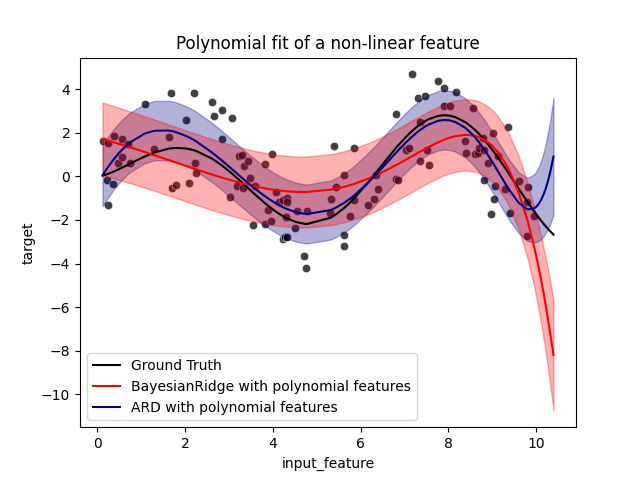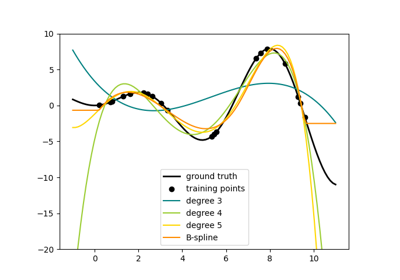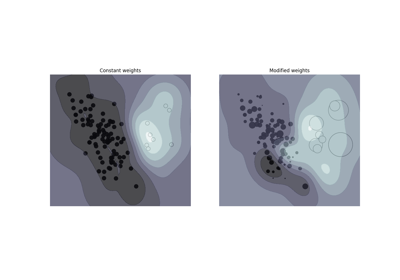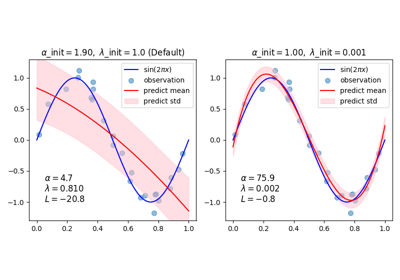备注
Go to the end 下载完整的示例代码。或者通过浏览器中的MysterLite或Binder运行此示例
比较线性Bayesian回归量#
此示例比较了两个不同的bavoy回归量:
在第一部分中,我们使用 普通最小二乘 (OLS)模型作为基线,用于将模型的系数与真实系数进行比较。此后,我们表明,这样的模型的估计是通过迭代最大化的边际对数似然的观察。
在最后一节中,我们使用多项特征展开来绘制ARD和Bayesian Ridge回归的预测和不确定性,以适应两者之间的非线性关系 X 和 y .
# Authors: The scikit-learn developers
# SPDX-License-Identifier: BSD-3-Clause
模型恢复地面真值权重的稳健性#
生成合成数据集#
我们生成一个数据集, X 和 y 呈线性联系:10个特征 X 将用于生成 y .其他功能对于预测没有用处 y .此外,我们生成一个数据集,其中 n_samples == n_features .这种设置对于OLS模型来说是具有挑战性的,并且可能导致任意的大权重。拥有重量优先权和处罚会加剧问题。最后,添加高斯噪音。
from sklearn.datasets import make_regression
X, y, true_weights = make_regression(
n_samples=100,
n_features=100,
n_informative=10,
noise=8,
coef=True,
random_state=42,
)
适应回归量#
现在,我们对Bayesian模型和OLS进行匹配,以便稍后比较模型的系数。
import pandas as pd
from sklearn.linear_model import ARDRegression, BayesianRidge, LinearRegression
olr = LinearRegression().fit(X, y)
brr = BayesianRidge(compute_score=True, max_iter=30).fit(X, y)
ard = ARDRegression(compute_score=True, max_iter=30).fit(X, y)
df = pd.DataFrame(
{
"Weights of true generative process": true_weights,
"ARDRegression": ard.coef_,
"BayesianRidge": brr.coef_,
"LinearRegression": olr.coef_,
}
)
绘制真实系数和估计系数#
现在我们将每个模型的系数与真实生成模型的权重进行比较。
import matplotlib.pyplot as plt
import seaborn as sns
from matplotlib.colors import SymLogNorm
plt.figure(figsize=(10, 6))
ax = sns.heatmap(
df.T,
norm=SymLogNorm(linthresh=10e-4, vmin=-80, vmax=80),
cbar_kws={"label": "coefficients' values"},
cmap="seismic_r",
)
plt.ylabel("linear model")
plt.xlabel("coefficients")
plt.tight_layout(rect=(0, 0, 1, 0.95))
_ = plt.title("Models' coefficients")

由于增加的噪音,没有一个模型恢复真实权重。事实上,所有模型总是有10个以上的非零系数。与OLS估计器相比,使用Bayesian Ridge回归的系数稍微向零移动,从而使它们稳定。ARD回归提供了一种更稀疏的解决方案:一些非信息系数被完全设置为零,而将其他系数移至更接近零。一些非信息系数仍然存在并保留很大的值。
绘制边际log似然#
import numpy as np
ard_scores = -np.array(ard.scores_)
brr_scores = -np.array(brr.scores_)
plt.plot(ard_scores, color="navy", label="ARD")
plt.plot(brr_scores, color="red", label="BayesianRidge")
plt.ylabel("Log-likelihood")
plt.xlabel("Iterations")
plt.xlim(1, 30)
plt.legend()
_ = plt.title("Models log-likelihood")

事实上,这两个模型都将log似然最小化到由 max_iter 参数.
具有多项特征扩展的Bayesian回归#
生成合成数据集#
我们创建一个目标,该目标是输入特征的非线性函数。添加遵循标准均匀分布的噪音。
from sklearn.pipeline import make_pipeline
from sklearn.preprocessing import PolynomialFeatures, StandardScaler
rng = np.random.RandomState(0)
n_samples = 110
# sort the data to make plotting easier later
X = np.sort(-10 * rng.rand(n_samples) + 10)
noise = rng.normal(0, 1, n_samples) * 1.35
y = np.sqrt(X) * np.sin(X) + noise
full_data = pd.DataFrame({"input_feature": X, "target": y})
X = X.reshape((-1, 1))
# extrapolation
X_plot = np.linspace(10, 10.4, 10)
y_plot = np.sqrt(X_plot) * np.sin(X_plot)
X_plot = np.concatenate((X, X_plot.reshape((-1, 1))))
y_plot = np.concatenate((y - noise, y_plot))
适应回归量#
Here we try a degree 10 polynomial to potentially overfit, though the bayesian
linear models regularize the size of the polynomial coefficients. As
fit_intercept=True by default for
ARDRegression and
BayesianRidge, then
PolynomialFeatures should not introduce an
additional bias feature. By setting return_std=True, the bayesian regressors
return the standard deviation of the posterior distribution for the model
parameters.
ard_poly = make_pipeline(
PolynomialFeatures(degree=10, include_bias=False),
StandardScaler(),
ARDRegression(),
).fit(X, y)
brr_poly = make_pipeline(
PolynomialFeatures(degree=10, include_bias=False),
StandardScaler(),
BayesianRidge(),
).fit(X, y)
y_ard, y_ard_std = ard_poly.predict(X_plot, return_std=True)
y_brr, y_brr_std = brr_poly.predict(X_plot, return_std=True)
用分数的std误差绘制多元回归#
ax = sns.scatterplot(
data=full_data, x="input_feature", y="target", color="black", alpha=0.75
)
ax.plot(X_plot, y_plot, color="black", label="Ground Truth")
ax.plot(X_plot, y_brr, color="red", label="BayesianRidge with polynomial features")
ax.plot(X_plot, y_ard, color="navy", label="ARD with polynomial features")
ax.fill_between(
X_plot.ravel(),
y_ard - y_ard_std,
y_ard + y_ard_std,
color="navy",
alpha=0.3,
)
ax.fill_between(
X_plot.ravel(),
y_brr - y_brr_std,
y_brr + y_brr_std,
color="red",
alpha=0.3,
)
ax.legend()
_ = ax.set_title("Polynomial fit of a non-linear feature")

误差线代表查询点的预测高斯分布的一个标准差。请注意,当在两个模型中使用默认参数时,ARD回归能够最好地捕捉到基本事实,但进一步减少了 lambda_init 贝叶斯岭的超参数可以减少其偏差(参见示例 利用Bayesian Ridge回归进行曲线匹配 ).最后,由于多元回归的固有局限性,两个模型在外推时都会失败。
Total running time of the script: (0分0.840秒)
相关实例
Gallery generated by Sphinx-Gallery <https://sphinx-gallery.github.io> _




